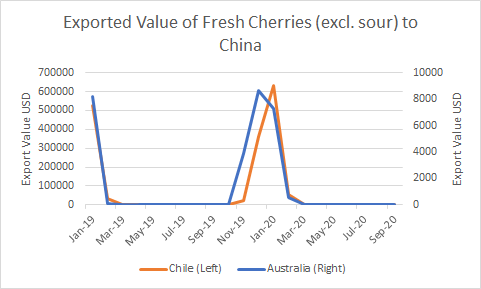Australian Stone fruits Set to Suffer from Labor Shortages, Trade Disputes
With stonefruits being well into their peak season, Australian farmers are facing a severe shortage of laborers ever since coronavirus restrictions have limited seasonal workers from entering the country. As one of the top stonefruit exporters, the shortage could impact the volume of exports to its largest importer, China, where relations are already tense.
Lockdown Restrictions Impact Agriculture
With the inception of the seasonal worker program in 2008, thousands of people have entered Australia from nearby Pacific countries for fruit harvests, where in just 2016-17, 6,166 workers came via the program. With the arrival of COVID, however, workers were unable to enter the country, and some of the existing workers were put on flights back home. The lack of manpower to pick the fruits is many farmer’s worst fear, as ripe fruits ready to be harvested will be left to rot. The decrease in production due to the unharvested fruits will be reflected in the prices, where the costs of fruits and vegetables for consumers are expected to increase by 25 cents in the summer of 2021.
Trade Dispute with China to Hit Export Demand
To add to the coronavirus woes, Australia’s relationship with China has turned sour ever since Australia has advocated for an inquiry into China’s role during the pandemic, wreaking havoc on Australian exports. For stonefruits, in particular, China held a little over half (43.2%) of Australian exports in 2019, illustrating how the absence of China will be detrimental to many growers. Australian fruits are currently safe from trade restrictions, but deteriorating trade relations will likely cause China to promote other markets instead. For Australian cherries (HS 080929), China has deemed them of lower quality and has begun to push for Chilean cherries, which has been unfazed by the coronavirus with production and exports expected to be positive through MY 2020/21. If any tariffs were to be imposed, this would hurt Australia’s cherry prospects, where its exports to China only begun in 2017.

Source: ITC Trade Map.
As Australian fruits tiptoe around the potential of being bombarded with tariffs as the barley, beef, and wine industry have, the country could look to other export markets, mostly within Asia. Located strategically closer to Asian countries than most cherry-producing countries in the Southern hemisphere, Australia has the advantage of low-cost air freight. Top export destinations for cherries other than China are Vietnam, Singapore, among others. Exports to Vietnam, especially, has recorded exceptional growth in exported value of 1,142% between 2015-19.
Sources
- The Guardian. "The fruit pickers:inside Australia's seasonal worker program – a photo essay."
- SBS News. "Who are Australia's seasonal workers?"
- The Sydney Morning Herald. "Fruit and vegetable prices set to rise as competition for labour intensifies"
- Cherry Growers Australia. Australian Cherry Export Roadmap 2012-2017
- ITC Trade Map.





